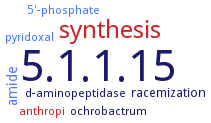5.1.1.15: 2-aminohexano-6-lactam racemase
This is an abbreviated version!
For detailed information about 2-aminohexano-6-lactam racemase, go to the full flat file.

Word Map on EC 5.1.1.15 
-
5.1.1.15
-
synthesis
-
amide
-
racemization
-
d-aminopeptidase
-
5'-phosphate
-
ochrobactrum
-
pyridoxal
-
anthropi
- 5.1.1.15
- synthesis
- amide
-
racemization
- d-aminopeptidase
- 5'-phosphate
-
ochrobactrum
- pyridoxal
- anthropi
Reaction
Synonyms
ACL racemase, ACLR, alpha-Amino-delta-valerolactam racemase, alpha-Amino-epsilon-caprolactam racemase, Aminocaprolactam racemase, moe, More, Racemase, alpha-amino-epsilon-caprolactam, Racemase, alpha-amino-epsilon-caprolactam (Achromobacter obae reduced), SMc02413
ECTree
Advanced search results
General Information
General Information on EC 5.1.1.15 - 2-aminohexano-6-lactam racemase
Please wait a moment until all data is loaded. This message will disappear when all data is loaded.
evolution
malfunction
the mutation of either Asp210 or Lys267 to alanine abolish the racemization activity for 2-aminohexano-6-lactam
additional information
analysis of the structure-function relationship, overview. Lys241 is a key amino acid residue, active site structure of ACL racemase. The substrate binding site is typically located between Trp49 and Tyr137. Lys241 Nepsilon is considered to be important for recognizing the carbonyl O of the substrate. Lys241 also forms a salt bridge with Glu396. Asp210 and Lys267 are two plausible acid/base catalytic candidate residues, situated on the re and si faces of the pyridoxal 5'-phosphate ring, respectively. The racemization of ACL racemase proceeds via a two-base mechanism
-
the deduced amino acid sequence of ACLR from Ensifer sp. 23-3 exhibits high similarity (99%) to that of aspartate aminotransferase family protein (UniProt ID W8HW01) from Ensifer adhaerens strain OV14
evolution
the enzyme belongs to the fold-type I PLP-dependent enzyme family


 results (
results ( results (
results ( top
top






